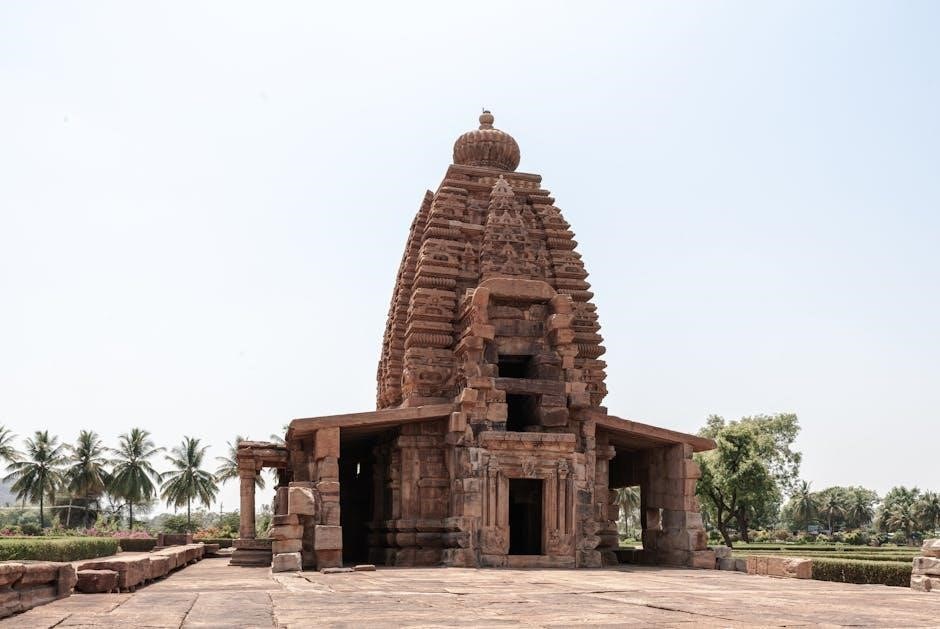
lalitha sahasranamam sanskrit pdf
The Lalitha Sahasranamam is a sacred Hindu text comprising one thousand names of Goddess Lalita, part of the Brahmanda Purana, revered in Devi worship, and available in downloadable PDF formats for spiritual growth and blessings.
1.1 Origin and Background
The Lalitha Sahasranamam, a revered Hindu text, originates from the Brahmanda Purana, an ancient scriptural source in Hinduism. It is part of the Devi Mahatmyam and holds significant importance in Devi worship, particularly within the Shaktism tradition. The text is structured into three chapters, with the second chapter dedicated to enumerating the thousand names of Goddess Lalita. These names, each imbued with profound spiritual meaning, are believed to have been recited by various deities at the behest of the goddess herself. Prominent scholars like Bhaskararaya have provided commentaries, enhancing its theological depth. Available in Sanskrit PDF formats, this hymn is widely accessible for devotees seeking spiritual growth and enlightenment, making it a cornerstone of Goddess Lalita’s glorification in Hindu spirituality.
1.2 The Thousand Names of Goddess Lalita
The Lalitha Sahasranamam enumerates one thousand names of Goddess Lalita, each describing her divine attributes, powers, and forms. These names, recited by deities, reflect her role as the divine mother and supreme energy. Names like “Shri Mata” and “Shri Mahalakshmi” highlight her nurturing and prosperous nature. The text also includes names that symbolize her cosmic roles, such as “Brahmani” and “Vaishnavi,” emphasizing her universal influence. Each name is a mantra, believed to invoke her blessings and foster spiritual growth. Available in Sanskrit PDFs, these names are chanted by devotees for worship, protection, and self-realization, making the Sahasranamam a powerful tool for connecting with the divine feminine energy in Hinduism.
1.3 Significance of the Sanskrit Text
The Lalitha Sahasranamam holds profound spiritual significance as a Sanskrit text, being part of the Brahmanda Purana and a cornerstone of Devi worship. Its thousand names, written in Sanskrit, are revered for their sacredness and lyrical beauty, embodying the divine attributes of Goddess Lalita. The text is structured into three chapters, with the second chapter dedicated to the enumeration of her names, each carrying deep philosophical and spiritual meaning. The use of Sanskrit underscores its antiquity and ritual importance, making it a foundational text for worship and meditation. PDF versions of the Sanskrit text are widely available, offering devotees easy access to this sacred hymn. These PDFs often include transliterations and translations, ensuring the text remains accessible while preserving its original sanctity and spiritual potency for global devotees seeking enlightenment and divine connection.

Significance of Lalitha Sahasranamam
Lalitha Sahasranamam is a revered hymn in Hinduism, celebrated for its cultural impact, spiritual depth, and ritual significance, offering devotees a pathway to enlightenment, prosperity, and divine connection.
2.1 Religious Importance in Hinduism
Lalitha Sahasranamam holds profound religious significance in Hinduism, particularly in Devi worship, as it embodies the divine attributes of Goddess Lalita, a manifestation of the Supreme Feminine Power. This sacred hymn, part of the Brahmanda Purana, is revered for its spiritual depth and ritualistic importance. Devotees believe that chanting the thousand names of Lalita fosters spiritual growth, self-realization, and a deep connection with the divine. The text is often recited in temples and during rituals to invoke the goddess’s blessings, ensuring material prosperity and spiritual enlightenment. Its religious importance is further underscored by its inclusion in sacred scriptures and its role in Shaktism, a major tradition within Hinduism. The availability of Lalitha Sahasranamam in Sanskrit PDF formats has made it accessible for global devotees to study, chant, and integrate into their daily worship practices, enhancing its religious and cultural impact.
2.2 Cultural Impact and Reverence
Lalitha Sahasranamam holds a significant cultural impact, transcending its religious roots to become a revered text in Hindu tradition. Its thousand names of Goddess Lalita are celebrated in various art forms, rituals, and literary works, reflecting the divine feminine power. The hymn is often recited in temples and cultural festivals, fostering a sense of community and spiritual unity. Its influence extends to classical music and dance, where verses are used to evoke devotion and aesthetic expression. The availability of Lalitha Sahasranamam in Sanskrit PDF formats has further enhanced its cultural reach, allowing global devotees to access and cherish this sacred text. It is considered a cultural treasure, bridging the gap between spirituality and artistic expression, and continues to inspire reverence across generations.
2.3 Spiritual Enlightenment and Worship
Lalitha Sahasranamam is a powerful tool for spiritual enlightenment, guiding devotees toward self-realization and inner peace. Chanting the thousand names of Goddess Lalita is believed to purify the mind, dissolve ego, and foster a deep connection with the divine feminine. The hymn is often recited during meditation and worship, creating a sacred atmosphere for spiritual growth. Its verses are structured to evoke devotion, introspection, and a surrender to the divine will. Devotees believe that reciting Lalitha Sahasranamam with sincerity attracts divine blessings, mitigates life’s challenges, and accelerates spiritual progress. The text’s profound spiritual significance is enhanced by its availability in Sanskrit PDF formats, enabling devotees worldwide to engage in meaningful worship and deepen their spiritual practice.

Structure of the Text

Lalitha Sahasranamam is structured into three chapters, with the first introducing the text, the second listing the thousand names, and the third concluding with spiritual insights and divine praises.
3.1 Division into Chapters
The Lalitha Sahasranamam is divided into three distinct chapters, each serving a unique purpose. The first chapter introduces the divine context and sets the stage for the recitation of the thousand names. It elaborates on the origins and significance of the hymn, providing a foundational understanding for devotees. The second chapter is dedicated entirely to the enumeration of the thousand names of Goddess Lalita, each name highlighting a specific attribute, power, or aspect of the divine feminine. The third chapter concludes the text with a summary of the spiritual and philosophical implications, reinforcing the importance of devotion and worship. This structured division enhances the accessibility and comprehension of the sacred text, making it a comprehensive guide for spiritual seekers and scholars alike.
3.2 Composition of Verses
The Lalitha Sahasranamam is composed of verses written in Sanskrit, following the traditional poetic structure of ancient Indian texts; Each verse is a couplet, known as a “sloka,” which adheres to specific rhythmic patterns and meters, such as the Anustup meter. The text is divided into three chapters, with the second chapter exclusively dedicated to the enumeration of the thousand names of Goddess Lalita. These verses are not only poetic but also deeply symbolic, conveying the divine attributes, powers, and forms of the goddess. The composition reflects a blend of spiritual and literary excellence, making it a revered text for both scholarly study and devotional chanting. The systematic arrangement of the verses ensures a harmonious flow, facilitating meditation and worship. This sacred hymn is a masterpiece of Sanskrit literature, encapsulating the essence of Hindu spirituality and devotion to the divine feminine.

3.3 Enumeration of the Thousand Names
The Lalitha Sahasranamam meticulously enumerates the thousand names of Goddess Lalita, each name highlighting a unique attribute, power, or form of the divine feminine. These names are not merely descriptive but carry profound spiritual significance, encapsulating the goddess’s cosmic roles and benevolent qualities. The enumeration begins with “Sri Mata,” symbolizing her role as the universal mother, and progresses through names that reflect her creative, preservative, and transformative aspects. Each name serves as a mantra, offering spiritual insight and connection to the divine. The systematic enumeration in Sanskrit ensures a rhythmic and meditative quality, making it ideal for chanting and contemplation. This section of the text is a cornerstone of Devi worship, enabling devotees to delve into the mysteries of the goddess and seek her blessings through recitation.
Benefits of Lalitha Sahasranamam
Chanting Lalitha Sahasranamam offers spiritual growth, self-realization, material prosperity, health, and well-being. Available in Sanskrit PDF, it provides a transformative experience, fostering divine connection and blessings for devotees.
4.1 Spiritual Growth and Self-Realization
The Lalitha Sahasranamam is a powerful tool for spiritual growth and self-realization. By chanting the thousand names of Goddess Lalita, devotees connect with her divine energy, fostering inner peace and enlightenment. The sacred hymn, available in Sanskrit PDF, helps seekers understand the deeper aspects of the universe and their true selves. Each name carries profound spiritual significance, guiding individuals toward self-realization and liberation. Regular recitation enhances meditation practices, purifies the mind, and strengthens one’s spiritual journey. The text, part of the Brahmanda Purana, is revered for its ability to transform consciousness and bring devotees closer to the divine feminine energy. Through this sacred chant, practitioners experience spiritual awakening, aligning their souls with the ultimate reality.
4.2 Attainment of Material Prosperity
The Lalitha Sahasranamam is also believed to bestow material prosperity upon its devotees. Chanting the thousand names of Goddess Lalita is thought to attract wealth, success, and good fortune. The sacred text, available in Sanskrit PDF, is often recited to seek blessings for financial stability, career advancement, and worldly happiness. Devotees believe that the divine energy of Lalita Devi helps overcome obstacles and fosters a prosperous life. The hymn’s verses are said to create a favorable environment for achieving material goals while maintaining spiritual balance. Many followers attest to experiencing positive changes in their lives after regularly chanting the Sahasranamam. This aspect makes it a popular choice for those seeking both spiritual and material fulfillment, as it is believed to harmonize worldly success with divine grace. The PDF versions of the text are widely accessible, making it easier for devotees to incorporate this practice into their daily lives.
4.3 Health and Well-being
The Lalitha Sahasranamam is also believed to promote health and well-being. Devotees trust that chanting the thousand names of Goddess Lalita can bring balance and harmony to one’s life. The sacred hymn, available in Sanskrit PDF, is often recited for healing and to ward off ailments. It is thought to foster mental clarity, emotional stability, and physical health. Many followers believe that the divine energy of Lalita Devi helps alleviate stress and sickness, bringing overall well-being. The text’s verses are said to create a protective shield against negative influences, ensuring holistic health. Regular chanting is believed to enhance vitality and longevity, making it a popular practice for those seeking both spiritual and physical wellness. The accessibility of the PDF version allows devotees to easily incorporate this practice into their daily routines for sustained health benefits. This ancient text remains a powerful tool for maintaining a healthy and balanced life.
4.4 Power of Chanting the Names
Chanting the thousand names of Goddess Lalita, as detailed in the Lalitha Sahasranamam, is believed to hold immense spiritual power. Devotees trust that reciting these names invokes divine grace, offering protection, peace, and prosperity. The sacred hymn, available in Sanskrit PDF, is often chanted to seek blessings and fulfill desires; It is said that the vibrations from the chants create a positive energy field, warding off negativity and attracting auspiciousness. Regular recitation is believed to enhance spiritual growth and strengthen one’s connection with the divine. The chanting is also thought to bring clarity of mind and purity of heart. Many followers believe that the collective energy of the thousand names amplifies the effects of the prayer, leading to profound spiritual and material benefits. The PDF version makes it easier for devotees worldwide to access and practice this powerful ritual.

Lalitha Sahasranamam PDF Versions
The Lalitha Sahasranamam is available in PDF formats on platforms like Internet Archive, Scribd, and Austin Hindu Temple, offering Sanskrit text, transliterations, and translations with scholarly commentaries.

5.1 Sources for Downloading the PDF
Devotees can access the Lalitha Sahasranamam PDF from reputable sources like the Internet Archive, Scribd, and the Austin Hindu Temple website. These platforms offer free downloads, ensuring easy accessibility for spiritual seekers. The PDFs typically include the original Sanskrit text, accompanied by transliterations and translations, making it convenient for both scholars and laypersons to study and recite. Additionally, some versions include commentaries by esteemed scholars like Bhaskararaya and M. Giridhar, providing deeper insights into the significance of each name. These sources are trusted for their authenticity and quality, ensuring that devotees can engage with the sacred text in a meaningful way.
5;2 Transliteration for Easy Reading
The Lalitha Sahasranamam PDFs often include transliterations of the Sanskrit text, making it accessible to those unfamiliar with Devanagari script. This feature is particularly beneficial for non-Sanskrit speakers, allowing them to recite the names accurately. The transliterated versions are presented in a clear, easy-to-read format, often alongside the original Sanskrit text. This dual presentation ensures that devotees worldwide can engage with the sacred hymn without language barriers. Many PDFs, such as those from the Internet Archive and Sri Ramakrishna Math, include both the Sanskrit text and its Romanized transliteration, enhancing the universality of the text. Additionally, some versions include English translations, further aiding in understanding and spiritual connection. This approach ensures that the divine names of Goddess Lalita are accessible and meaningful to all seekers.

5.3 English Translations for Global Devotees
English translations of the Lalitha Sahasranamam are widely available in PDF formats, catering to global devotees who seek a deeper understanding of the text. These translations provide a clear and meaningful interpretation of each of the thousand names, allowing readers to connect with the spiritual essence of Goddess Lalita. Published by esteemed organizations such as Sri Ramakrishna Math and other spiritual institutions, these translations often accompany the original Sanskrit text and its transliteration. This comprehensive approach ensures that devotees from diverse linguistic backgrounds can appreciate the sacred hymn’s significance. The English translations are meticulously crafted to preserve the poetic and spiritual nuances of the original Sanskrit verses, making the text accessible and inspiring for a global audience. This inclusion of English translations has played a pivotal role in spreading the reverence for Lalitha Sahasranamam worldwide.
5.4 Commentaries for Deeper Understanding
Commentaries on the Lalitha Sahasranamam are invaluable resources for devotees seeking a deeper understanding of its spiritual and philosophical significance. These commentaries, often included in PDF versions of the text, provide detailed explanations of each name, unlocking their esoteric meanings. Scholars like Bhaskararaya Makhi and M. Giridhar have authored extensive commentaries, offering insights into the mystical aspects of Goddess Lalita. Their works bridge the gap between the ancient Sanskrit text and modern readers, making the divine attributes and symbolism more accessible. These commentaries not only enhance the devotional experience but also serve as educational tools for those exploring Hindu spirituality. By incorporating these interpretations, the Lalitha Sahasranamam becomes a richer and more profound text for global audiences, fostering both intellectual and spiritual growth.

How to Use the Lalitha Sahasranamam
Download the Lalitha Sahasranamam PDF for easy access, ensuring proper recitation and study. Incorporate it into daily rituals for spiritual growth, using transliterations for clear pronunciation and deeper connection with the divine;
6.1 Guidelines for Downloading the PDF
To download the Lalitha Sahasranamam PDF, visit trusted platforms like the Internet Archive or Sri Ramakrishna Math, Mylapore. Search for “Lalitha Sahasranamam Sanskrit PDF” to find authentic sources. Ensure the file includes the Sanskrit text, transliterations, and translations for easy understanding. Some PDFs may also contain commentaries by scholars like Bhaskararaya or M. Giridhar, offering deeper insights. Always preview the document to verify its completeness and relevance. Download from secure, reputable websites to avoid unauthorized content. Once downloaded, save it for regular chanting and study. This PDF serves as a valuable resource for spiritual growth and worship, providing both the sacred text and its meanings.
6.2 Proper Recitation Techniques
Proper recitation of the Lalitha Sahasranamam requires focus and adherence to traditional guidelines. Begin by sitting in a calm, clean environment, preferably facing east or north. Light a lamp or incense to purify the space. Use the Sanskrit PDF for accurate pronunciation, as each name holds specific energy. Recite slowly, enunciating each syllable clearly, and maintain concentration to avoid distractions. Ideal times for recitation are during early morning or evening hours. Regular practice, even daily, enhances spiritual benefits. Chanting with devotion and understanding amplifies its effectiveness. For deeper meditation, use a rosary to count repetitions. Avoid interruptions and maintain a serene mindset throughout the recitation. Consistency and sincerity are key to deriving the full spiritual and material benefits of this sacred hymn.
6.3 Methods for Studying the Text
Studying the Lalitha Sahasranamam requires a systematic and reverential approach. Begin by downloading the Sanskrit PDF, which provides the authentic text for accurate recitation. Use transliterations to aid pronunciation if unfamiliar with Sanskrit. For deeper understanding, refer to commentaries by scholars like Bhaskararaya or M. Giridhar, which explain the spiritual significance of each name. Group study with fellow devotees can enhance comprehension and foster a collective spiritual atmosphere. Practice reciting a few names daily, reflecting on their meanings and spiritual implications. Seek guidance from gurus or experienced practitioners to clarify doubts. Regularly review the text, gradually increasing familiarity with its structure and content. Integrate the study with rituals or meditation for a holistic experience. Consistent and dedicated study of the Lalitha Sahasranamam fosters spiritual growth and a profound connection with Goddess Lalita.

6.4 Incorporating into Daily Rituals
Incorporating the Lalitha Sahasranamam into daily rituals enhances spiritual practice and devotion. Begin by reciting the hymn at dawn or dusk, considered auspicious times, to invoke Goddess Lalita’s blessings. Create a sacred space with a puja setup, including offerings like flowers, incense, and lamps, to foster a reverent atmosphere. Chant a few names daily, gradually increasing the number as familiarity grows. Reflect on the meanings of the names to deepen spiritual understanding and connection. Conclude each session with gratitude, seeking divine grace for well-being and enlightenment. Regular recitation cultivates mindfulness and devotion, integrating the divine into daily life. This consistent practice not only honors Goddess Lalita but also nurtures personal spiritual growth and harmony.
The Lalitha Sahasranamam is a revered text offering profound spiritual growth and divine connection, available in Sanskrit PDF formats for global devotees seeking enlightenment and Goddess Lalita’s blessings.
7.1 Final Thoughts on the Importance
The Lalitha Sahasranamam holds immense spiritual significance as a sacred hymn dedicated to Goddess Lalita, offering devotees a profound path to enlightenment and divine connection. Its availability in Sanskrit PDF formats ensures accessibility for global worshipers, preserving ancient traditions while embracing modern technology; This revered text not only embodies the essence of Hindu spirituality but also serves as a cultural treasure, fostering devotion and inspiring countless followers. By chanting or studying the Lalitha Sahasranamam, individuals can experience spiritual growth, material prosperity, and inner peace, making it a timeless guide for seekers of truth and harmony. Its enduring relevance underscores its importance as a cornerstone of Hindu religious and cultural heritage, continuing to inspire and uplift generations.
7.2 Encouragement for Regular Chanting
Regular chanting of the Lalitha Sahasranamam is highly recommended for its profound spiritual and emotional benefits. This sacred hymn, available in Sanskrit PDF formats, serves as a powerful tool for connecting with the divine feminine energy of Goddess Lalita. By incorporating it into daily rituals, devotees can experience spiritual growth, mental clarity, and inner peace. The consistent recitation of these thousand names fosters a deeper understanding of the goddess’s attributes, leading to self-realization and material prosperity. Additionally, chanting is believed to enhance health and well-being, offering protection and blessings in daily life. The availability of PDF versions in Sanskrit ensures accessibility for global devotees, making it easier to embrace this ancient practice. Embrace the tradition of regular chanting to harness its transformative power and cultivate a stronger spiritual foundation.
Related posts:
Archives
Calendar
| M | T | W | T | F | S | S |
|---|---|---|---|---|---|---|
| 1 | 2 | 3 | 4 | 5 | 6 | 7 |
| 8 | 9 | 10 | 11 | 12 | 13 | 14 |
| 15 | 16 | 17 | 18 | 19 | 20 | 21 |
| 22 | 23 | 24 | 25 | 26 | 27 | 28 |
| 29 | 30 | 31 | ||||
Leave a Reply
You must be logged in to post a comment.